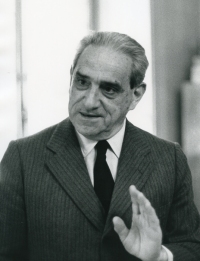The founder, Professor Marcello Comel
Marcello Comel was born in 1902 in Trieste from a Friulian family.
He studied medicine at the Universities of Genova, Pisa and Turin with an attention to the Institutes of Physiology and Patology. In 1926 he graduated at the University of Turin, with a thesis worthy of publication and which awarded the Vitaleni prize in 1926.
In 1929 he became Assistant Professor at the University of Milan, where his first course in Skin Physiology addressed to Dermatology postgraduated (the lessons are collected in the “Giornale Italiano di Dermatologia”).
In 1938, after 133 scientific papers, he had a Chair in Clinical Dermosyphilopathy at the University of Modena.
In December 1946, after some ordeals due to the War period, he was called to lead the small Clinic of Pisa, where he adapted the equipment, renovated services, expanded – and introduced new ones – departments for the biophysical, biochemical and physiochemical researches.
Thereafter he established in Pisa the first Italian Burn Center. During this period his Clinic was committed to combating the venereal disease originated from the Tombolo pine forest area.
The early Comel School has been enriched with a Library named after Santorio Santorio, the XVI Century physician as well-known as Galileo Galilei in medicine field (they were colleagues indeed). In the footsteps of Hippocrates, he teached the physical and organic human unity, the Medical Humanism.
In 1943 Comel drew up the constitution of the Institutum Santorianum de Humanitate Medica establishing a link with Santorio, continuing to promote the Medical Humanism in the name of the Experimental Medicine initiator, Santorio Santorio da Capodistria.
In 1950 Marcello Comel teached a course in Functional Dermatology in Buenos Aires.
On the 27th March 1995 at the age of 93 he passed away leaving his notes for a new book about the man and the environment.
From 1951 to 1989 Marcello Comel wrote 282 among papers, conference speeches and books about the issues he studied and which he dedicated his whole life to.
- Dermatology: in 1933 he published “Fisiologia normale e patologica della cute umana” (F.lli Treves Editori, Milano): a milestone of medical science field. In the remarkable preface A. Pasini highlighted two great values: it was the first work on skin physiology ever published and it was such comprehensive and thorough to be considered as an actual treaty.
- Eudermy: with the publication of “Principii di Eudermia” (Vannini Editore, Brescia, 1939), Comel led the way to the research and the experimentation of the dermo-cosmetic doctrine.
- Euginia: “Introduzione all’Euginia”, Anthologica Medica Santoriana, 1965.
- Medical Hydrology: Comel studied a lot and loved this subject. The three main titles of his publications are: “Terapia Idrologica Oligometallica”, 1963; “Idrologia Funzionale Oligometallica”, Saggio di Idrologia Funzionale, 1973; “La Sete Qualitativa dell’Uomo Moderno”, 1978.
- Angiology: in addition to the several papers dedicated to this issue, in 1958 Comel organised the III International Angiology Congress in Sanremo. In 1970 the Ratschow Prize was established in Germany and Professor Comel was the first to win the award with the paper “Betrachtungen ueber die Angiologie der Gegenwart und Zukunft” (“Observations about present and future Angiology”). It was followed by Professor Norbert Klueken from Essen laudatio.
- Phlebology: another subject related to Comel’s name; in 1974 he organised the V International Congress in Milan.
- General Medicine: in 1979 Comel published the “Quaderno Santoriano della Salute”, a book he addressed to his patients to persuade them that the “general medical care” (which was highlighted in his medical prescription) was fundamental. In the most part of cases, when put into practice diligently, it could solve disorders.
According to Comel general medical care lies in the observance of the health “3 gold rules” (Eat little and well; Chew a lot and well; a lot of well-done Physical Movement). In 1978 he added two more rules: Take care of oneself with peace of mind and the thoughtful observance of the orthobiosis and physio-phylaxis, related to life conditions in an ecophilus environment.
He organised several symposia about this issue in Lugano. - Ecology: in 1981 the essay “L’Uomo nel suo ambiente. Fisiologia ambientale: Ecofisiologia e Fisiecologia”, Editoriale Domus came up in hardcopy. The work focused on Ecology, a subject topical than ever today but which was not much considered at the time.• Ecology: in 1981 the essay “L’Uomo nel suo ambiente. Fisiologia ambientale: Ecofisiologia e Fisiecologia”, Editoriale Domus came up in hardcopy. The work focused on Ecology, a subject topical than ever today but which was not much considered at the time.
In 1992 Comel started the “Institutio Santoriana Fondazione Comel” with its headquarter in Milano, Via F.lli Maggiolini 1. His purpose was to continue the scientific and humanistic disclosure work achieved during his own life.
After Professor Marcello Comel death and synergically with other initiatives, the Foundation resumed from 1996 the publishing activity of the periodical “Anthologica Medica Santoriana” which Comel founded as far back as 1945.


